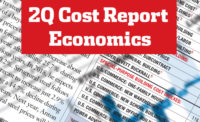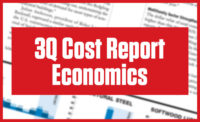One year into the COVID-19 pandemic, significant progress has been made toward economic recovery following the initial recession. Still, a long road ahead remains, particularly in construction.
“Economic headwinds felt in 2020 are quickly turning into a stiff tailwind in 2021 as additional federal stimulus makes its way to individuals and businesses in desperate need,” says Richard Branch, chief economist at Dodge Data & Analytics. “A further boost will come as more Americans receive the COVID-19 vaccine, unleashing a torrent of pent-up consumer demand.”
Despite an overall positive outlook, Branch expects the construction sector to be slower to bounce back. “Outside of the warehouse sector, building planning activity has been weak,” he says.
The dollar value of total construction starts in the first two months of 2021 is down 8% compared to the first two months of 2020, according to the Dodge Momentum Index. Non-residential building has taken the hardest hit, down 31% during the same time period.
Non-building construction is 2% higher over the first two months of the year, which Branch attributes to a number of energy, pipeline and water projects that have recently broken ground. Among the largest to start thus far in 2021 were the $2.1-billion Line 3 replacement program in Minnesota and the $1.2-billion Red River water supply project in North Dakota.
Residential construction continues to be the strongest sector, up 5% through February over the same time period last year. “Single family construction remains solid as buyers seek space away from dense urban areas, while multifamily activity has posted a sizeable decline through the early stages of 2021,” says Branch. Two large multifamily projects have broken ground in New York within the last two months, the $349-million Bronx Point mixed-use development and the $200-million GoBroome mixed-use development.
“As the year progresses, the construction sector will gain strength and starts activity will improve,” he adds. “But it will continue to be a long and rocky road back to full recovery.”
|
Related Link |
Lumber Prices Will Level
Following soaring prices for the majority of 2020, “we believe that lumber is poised for a correction,” says Deni Koenhemsi, economics manager, prices and purchasing, at IHS Markit.
In its first-quarter forecast, IHS Markit predicts a 19.2% increase in lumber in 2021, following a 30% price jump in 2020. The double digit boosts are largely due to the high demand in the single-family housing market.
“Most of the increases for 2021 will be concentrated in the first quarter of the year,” says Koenhemsi. “There is much anecdotal evidence of delayed projects owing to lumber availability issues. Domestic lumber supply in the U.S. actually increased last year, despite the stop-and-go nature of production due to the COVID-19 pandemic.”
IHS Markit forecasts a 19.1% drop in lumber prices in 2022, followed by a 3.4% decline in 2023. Koenhemsi attributes this to a wane in the high demand for housing throughout the pandemic.
“We expect that single-family housing starts will start running out of steam in the second quarter, dipping over several quarters,” says Koenhemsi. “This lower demand profile will allow lumber prices to fall—albeit gradually.”
Steel Price Drop by Q3
While prices are currently spiking due to material shortages, supply will soon catch up with demand for steel, says John Anton, associate director of pricing and purchasing at IHS Markit.
“Between the recovery in production and rising imports, supply shortages should improve in May and be gone by the third quarter,” he says. “Prices will tumble once inventory is flush.”
IHS Markit expects a modest 2.9% overall increase for structural sheet in 2021, up from the 0.9% decline that was predicted in the firm’s fourth quarter forecast.






Post a comment to this article
Report Abusive Comment